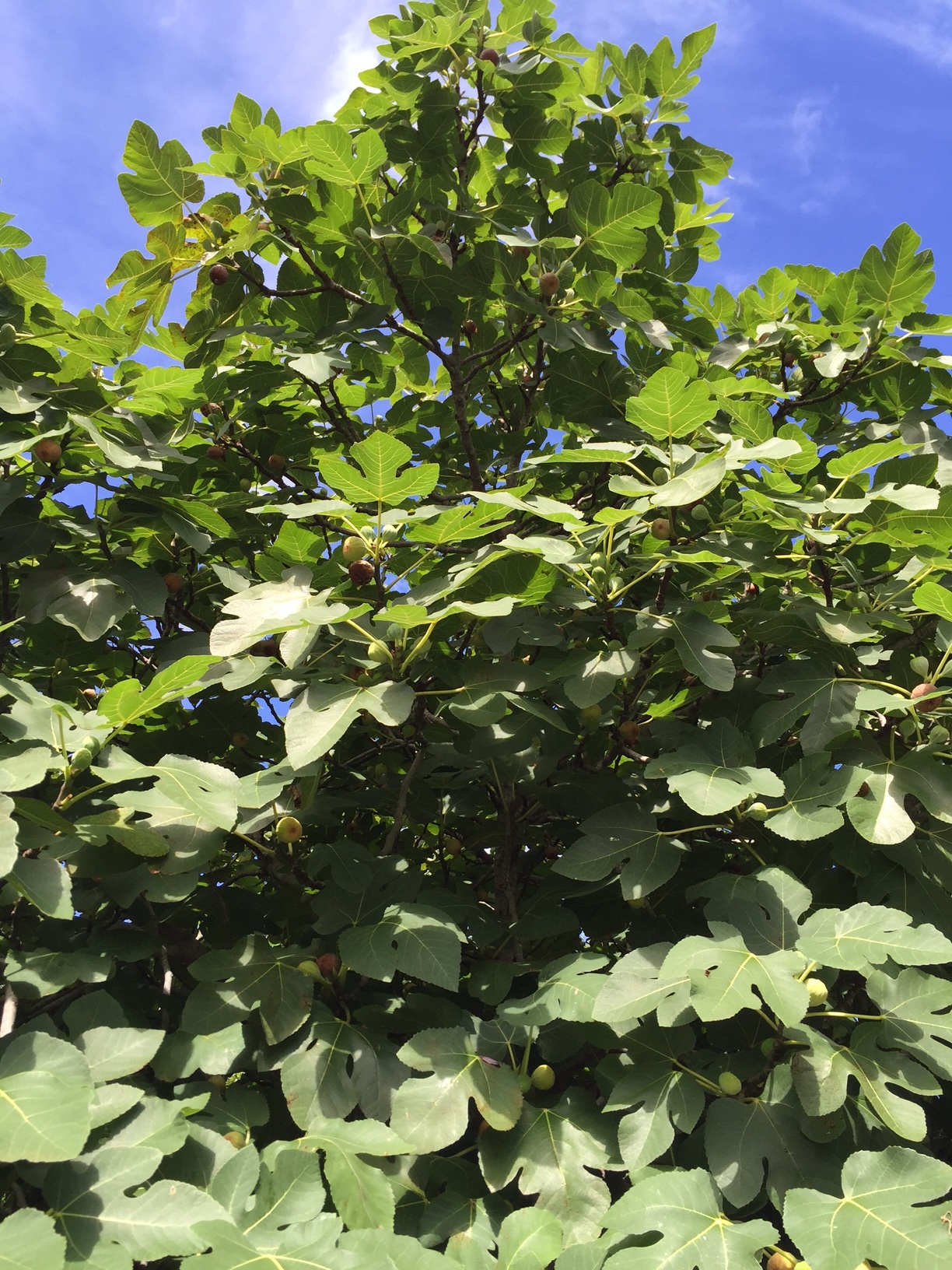
by Carrie Stevenson | Jul 26, 2016
Summer is full of simple pleasures—afternoon rainstorms, living in flip flops, and cooling off in a backyard pool. Among these, one of my favorites is walking out my door and picking handfuls of figs right from the tree. Before we planted our tree, my only prior experience with the fruit was a Fig Newton—I’d never eaten an actual fig, much less one picked fresh. Now, they are my favorite fruit.
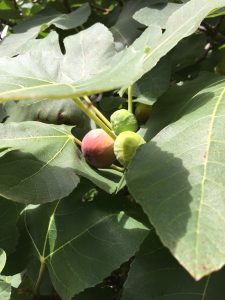
When ripe, figs are a deep shade of pink to purple. Larger green figs will ripen over the course of a few days. Photo credit: Carrie Stevenson
Native to Asia Minor and the Mediterranean, figs were introduced to Florida in the 1500’s by Spanish explorers. Spanish missionaries introduced these relatives of the mulberry to California a couple hundred years later. Figs are best suited to dry, Mediterranean-type climates, but do quite well in the southeast. Due to our humidity, southern-growing figs are typically fleshier and can split when heavy rains come through. The biggest threats to the health of the trees are insects, disease (also due to our more humid climate) and root-knot nematodes.
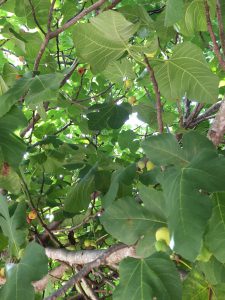
Fig trees can grow quite large and produce hundreds of fruit each year. Photo credit: Carrie Stevenson
Our tree started out just a couple of feet tall, but 12 years ago we replanted it along a fence in our back yard. It has grown so large (easily 25 feet tall and equally wide) that it hangs over our driveway, making it handy to grab a few as I hop in the car to run errands. The tree is in full sun at the bottom of a slope, and seems to be a satisfied recipient of all the runoff from our backyard. This position has resulted in a thick layer of soil and mulch in which it thrives.
We usually see small green fruit start to appear in early May, becoming fat and ripe by the second half of June. The tree produces steadily through early August, when the tree’s leaves turn crispy from the summer heat and there’s no more fruit to bear. The common fig doesn’t require a pollinator, so only one tree is necessary for production. The fiber-rich fig is also full of calcium, potassium, and vitamins A, E, and K. As it turns out, the “fruit” is actually a hollow peduncle (stem) that grows fleshy, forming a structure called a synconium. The synconium is full of unfertilized ovaries, making a fig a container that holds both tiny flowers and fruit in one.
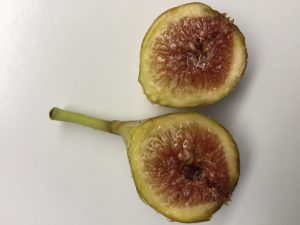
The insides of a fig show the small flowering structures that form the larger fruit. Photo credit: Carrie Stevenson
With the hundreds of figs we’ve picked, my family has made fig preserves, fig ice cream, baked figs and of course eaten them raw. We typically beg friends and neighbors to come help themselves—and bring a ladder—because we can’t keep up with the productivity. Often you can tell you’re near our tree from around the block, as the aroma of fermenting fruit baking on the driveway is far-reaching.
No matter what you do with them, I encourage planting these trees in your own yard to take full advantage of their sweet, healthy fruit and sprawling shade. As Bill Finch of the Mobile (AL) botanical gardens has written, “fresh…figs are fully enjoyed only by the family that grows them, and the very best figs are inevitably consumed by the person who picks them.”
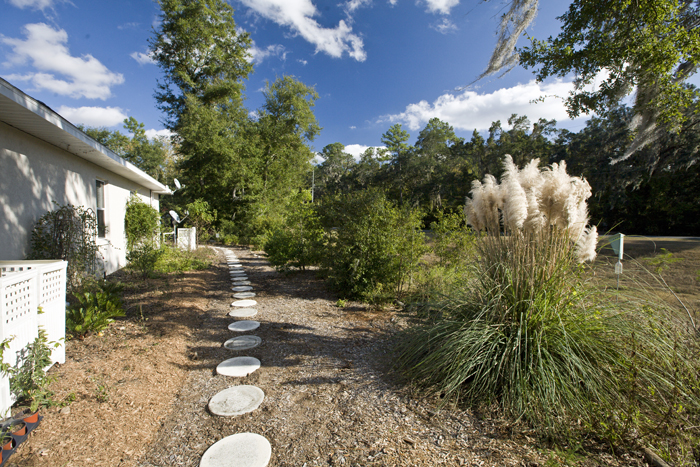
by Carrie Stevenson | Jul 19, 2016

Florida home and yard. Home, house, stone pavers, walkway, yard, landscaping. UF/IFAS Photo: Tyler Jones
Dr. Ramon Leon, Extension Weed Specialist, West Florida REC, Jay
Last year the International Agency for Research on Cancer (IARC) of the World Health Organization (WHO) classified glyphosate as “probably carcinogenic to humans.” This generated a lot of controversy because the Environmental Protection Agency (EPA), the European Food Safety Authority, and recently a joint report between the Food and Agriculture Organization (FAO) and WHO concluded that glyphosate is unlikely to be carcinogenic in humans.
As a University of Florida/IFAS Weed Specialist, I have been receiving multiple phone calls and e-mails from homeowners, homeowner associations (HOA), lawn care companies and contractors, municipalities, and county managers requesting a list of herbicides that are “safer” than glyphosate. When I ask them the reason for this particular preference, all of them acknowledged that their concern originated from hearing about the IARC report.
The first point that I always explain to people concerned about this issue is that most of the scientific evidence indicates that glyphosate does not have a higher carcinogenic risk compared to many other substances that they are normally exposed to in their daily activities. The second point is that it is important to continuously monitor how chemicals we use affect our health and the environment in the long run. The IARC report is a reminder that we should keep a close eye on glyphosate, the most widely used herbicide in the world, but it is not necessarily a call to stop using it, because at this point there is no direct evidence that it causes cancer in humans.
Very frequently, regardless of the technical details, many homeowners and citizens in urban areas are considering not using glyphosate in their gardens and landscapes, and they would like to use “safer” herbicides.
What do you mean by “safer?”
If you mean lower risk as a carcinogen, then most herbicides registered for use in urban areas would be acceptable because none of them are considered “probably carcinogenic” by IARC or any other regulatory agency. Therefore, you have multiple options to choose from. However, many of the conversations have lead to the statement, “No, I want something that is less toxic than glyphosate!”
Toxicity in pesticides is predominantly assessed using the lethal dose 50 (LD50), which indicates the amount of a chemical that kills 50% of a reference population of test animals (e.g. mice, rabbits, rats). When the LD50 is high, this means that the chemical has low toxicity, and when the LD50 is low it is considered that toxicity is higher because small amounts of the chemical can cause mortality. Glyphosate has one of the highest LD50s for herbicides. In other words, glyphosate is one of the least toxic herbicides available based on the LD50 standard. Therefore, if we want an alternative herbicide that is less toxic, we do not have any options for urban areas.
What about organic herbicides?
Many people associate “organic” with “safer.” This can be misleading because it depends on how safety is measured. For example, there are multiple organic herbicides that are considered to have the same or even higher toxicity when compared with glyphosate, because many of them have irritant and corrosive properties. Furthermore, organic herbicides have dramatically different herbicidal properties that make them unlikely alternatives to effectively replace glyphosate.
Glyphosate has one of the broadest spectrums of control, so it kills many different weed species effectively. Also, glyphosate works systemically. This means that it is absorbed by leaves and then moves inside the plant to growing points, roots, and other propagating structures. This systemic effect increases the ability to kill relatively large plants. In contrast, the majority of organic herbicides have a contact effect, so they only kill the tissue they touch without being able to move inside the plant. Therefore, they are effective at killing very small plants (<2 inches tall). Large plants can suffer leaf burning after treatment with organic herbicides, and if the application is done properly, the user will see a lot of control shortly after the application (Fig. 1). However, the plants will soon recover and the control level will decrease because, unlike plants treated with systemic herbicides, they can produce new growth from tissues that were not directly expose to the herbicide.
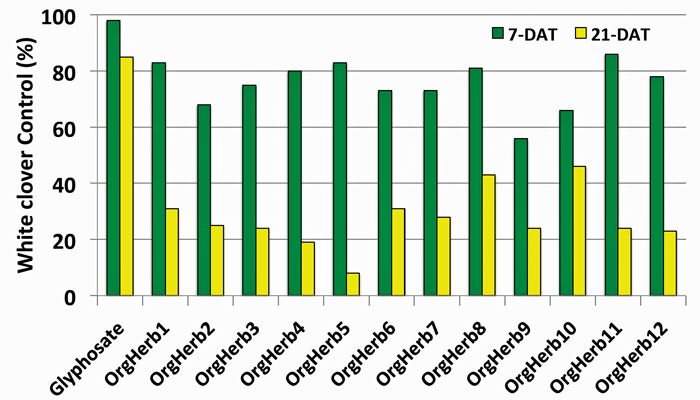
Figure 1. White clover (4 inches tall) control after treatment with glyphosate and twelve different organic herbicides based on natural oil extracts from plants. The green bars represent the level of control 7 days after treatment (DAT) and the yellow bars indicate control 21 DAT.
Considering the lack of alternatives to replace glyphosate, if you want to stop using this herbicide, and you do not want to use any other synthetic herbicides, because their toxicity might be higher, then you need to recognize that weed management will be more challenging. It is unfair to ask lawn care companies or members of HOAs to stop using the tools they have to control weeds and yet expect “weed free” lawns, gardens, and landscapes. Controlling weeds in these scenarios without glyphosate and other synthetic herbicides will require more intensive use of mechanical control approaches and hand weeding. Also, if relying on organic herbicides, these herbicides will have to be frequently applied (probably once or twice a week) in order to kill the weeds at the right time (before they get too big). Also, all these activities will increase weed control costs and the results will likely be not as satisfactory. Thus, you might end up paying more to have lawns and landscapes that will have more weeds escaping control. If this is not acceptable to you, then you probably should be more open to consider the weed control tools we have available. Also, you should be more vigilant about what are the appropriate ways to use them to minimize their risks to humans and the environment, while obtaining the benefits that you are seeking. Otherwise, you should get used to seeing more weeds in the landscape, and to be fair… this might not be as bad as some people think.
by Carrie Stevenson | Jun 1, 2016
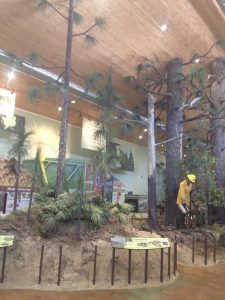
The longleaf forest display at the E.O. Wilson Biophilia Center shows typical vegetation and wildlife in the forest. Photo credit: UF IFAS Extension
Pine trees are so common in the southeastern United States that they are often taken for granted. They are usually the first to be cut down when homeowners are nervous about storms, and unless you’re in the tree-growing business, they are not considered all that valuable. However, the history and development of northwest Florida is intrinsically tied to the stately pine. During the 19th and early 20th centuries, the “naval stores” industry employed thousands of people collecting resin from pine trees. This industry produced turpentine and rosin used most famously to waterproof wooden ships, but also for soap, paint, inks, varnish, and medications.
Our area is home to seven native species, and each fulfills a specific role in the environment. In fact, during Florida Master Naturalist Program classes, we teach about pines living in all three of the broad Florida habitat types—uplands, freshwater wetlands, and coastal areas. These species can be difficult to tell apart, but a few tricks can help keep them straight.
The best way to keep track of pines is to recall that species starting with “S” (sand, shortleaf, spruce) have needles in bunches of twos (the letter S has two endpoints), and pines starting with “L” (a letter with 3 endpoints) have bunches of three (loblolly, longleaf). Finally, slash pine, starting with “SL” has bundles of 2-3 needles. Pond pine is an anomaly in that its shorter needles are in bunches of 3-5 needles.
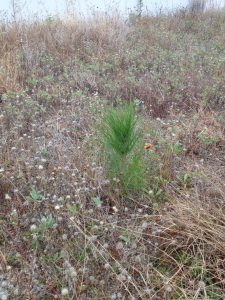
Longleaf pine sapling Photo credit: UF IFAS Extension
A few interesting facts on some of our native pine species:
- The Southeast was once covered in over 60 million acres of longleaf pine forests, the namesake of an ecological habitat that encompasses many valuable and endangered species, including bobwhite quail, red-cockaded woodpeckers, gopher tortoises, and indigo snakes. Wind resistant and adapted to frequent fires, the trees can grow 80-100 feet tall. One of the largest stands of longleaf pine in Florida is at Eglin Air Force Base.
- Pond pine often grows along the edges of wetlands and ponds. Its cones may stay closed on the tree for up to eight years, but if a fire comes through they will immediately open and release their seeds. This adaptation allows the species to take advantage of open soil in full sun after a fire to germinate new trees.
- Sand pine can grow in extremely sandy, low-nutrient soils, including beach dunes on the Gulf and Atlantic coasts. They have very short needles (2-3 inches long), and the “Choctawhatchee” variety of sand pine works well as a Christmas tree.
For detailed information on identifying all seven species along with several introduced pines, please see the new UF publication, “Common Pines of Florida.”
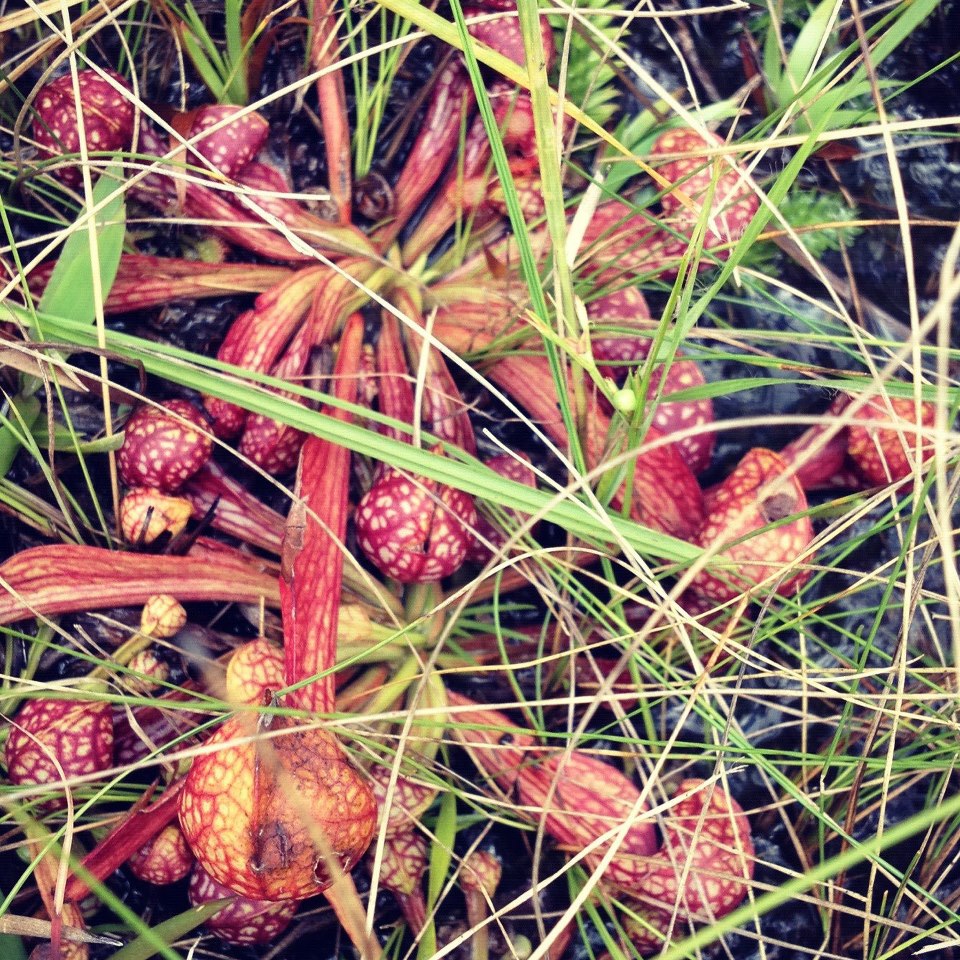
by Carrie Stevenson | Mar 29, 2016
Among the most fascinating natural phenomena in our area are the presence of dozens of species of carnivorous, or meat-eating, plants. Found in bogs, meadows, and seepage slopes with mucky, acidic soils and low levels of nutrients, these plants have adapted to their difficult conditions by developing ways to digest insects.These carnivores are best known by their common names; sundew, butterwort, bladderwort, and pitcher plants.
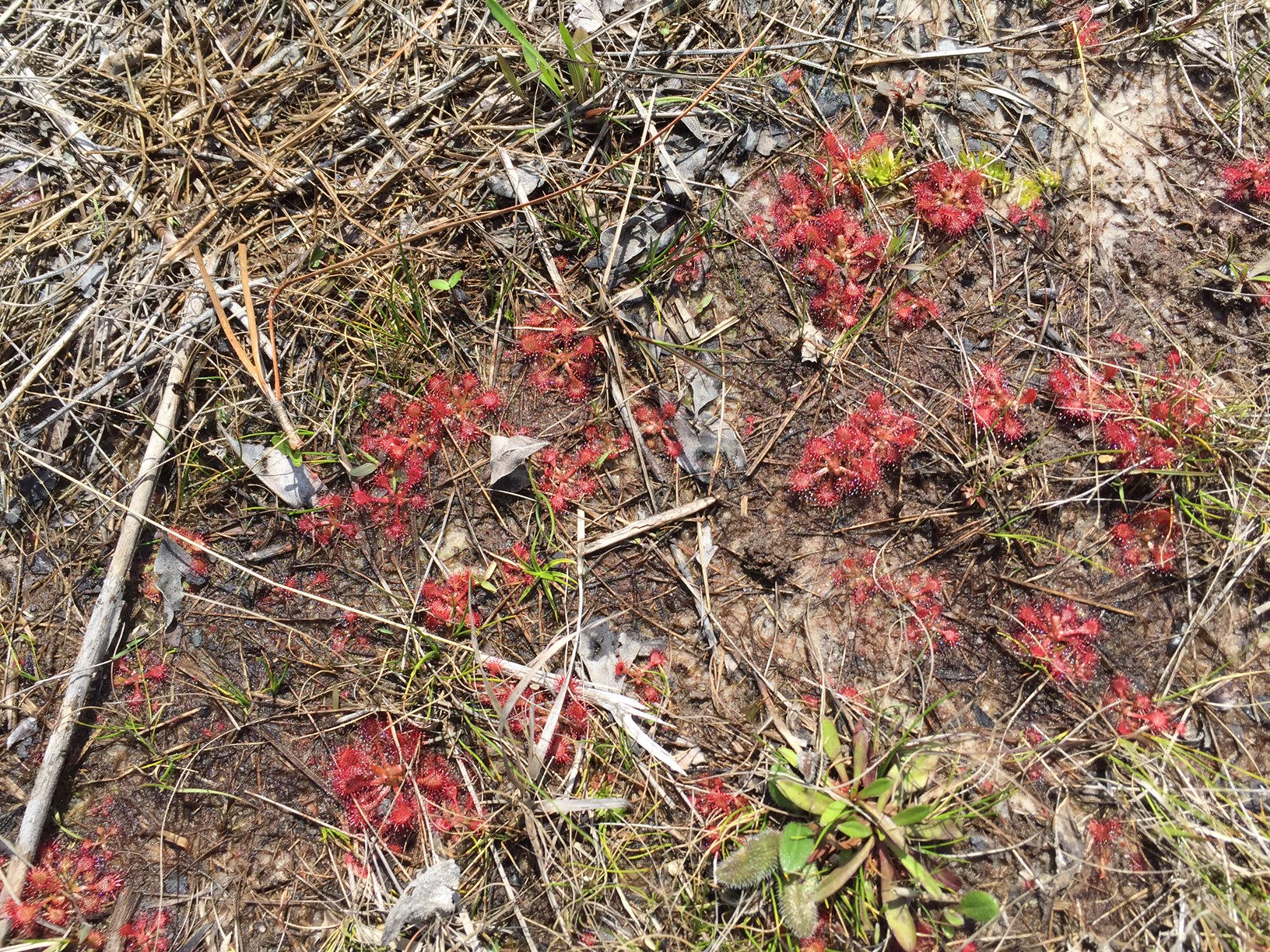
Sundew plants ready to feast
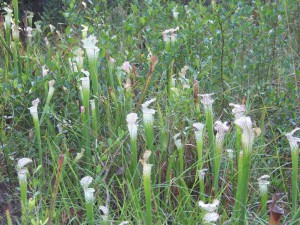
A meadow of white-topped pitcher plants in full spring bloom.
While there are six species of pitcher plants found in the panhandle and throughout the Gulf Coastal Plain, the “world’s largest concentration” can be found at Escambia County’s Tarkiln Bayou Preserve State Park. The “pitcher” part of the plant is actually a modified leaf, which is rounded into a hollow tube open at the top and partially covered by a hood. This hood is colorfully patterned, attracting insects also drawn to nectar inside the tubes. As insects crawl in, downward-facing hairs prevent them from escaping. They drown in the collected water within the tubes, then decompose via acids and enyzymes secreted by the plant into a “liquid fertilizer.” A handful of commensal animals, including flies, spiders, and small frogs, take advantage of the pitcher plants’ insect-trapping expertise and manage to avoid capture.
A guide to identifying all six of these pitcher plant species–white-top, parrot, trumpet-leaf, hooded, sweet, and yellow–can be found at the Florida Department of Environmental Protection’s wetland plant site. Now is the perfect time to see pitcher plants beginning to blossom.
While many people are familiar with pitcher plants, fewer notice the low-growing sundew. These plants may be smaller than a dime in circumference, and grow flat along very mucky soil in full sun. If shaded out even by relatively short grasses, sundew disappear. Their characteristic pinwheel-like appearance and deep red coloring help draw the eye if you look very closely. Sundews also excrete a sticky nectar, on which small insects get stuck and digested to provide nutrients to the plants.The leaves of butterwort plants work very similarly to sundews; they are typically bright green and succulent with sticky hairs that attract nutrients.
Bladderworts, also found in similar environments, use a different mechanism to trap insects. They actually have a bladder-like formation within their root system that opens and closes, siphoning water and unlucky insects in and out.
Regardless of their location, appearance, or method of trapping, carnivorous plants remain one of the most unusual, and interesting groups within the plant kingdom. Be sure to take the opportunity this spring to seek out a park or natural area populated with carnivorous plants–such as Tarkiln, Blackwater River State Park, or the public areas of Eglin Air Force Base and see them for yourself!

by Carrie Stevenson | Mar 2, 2016
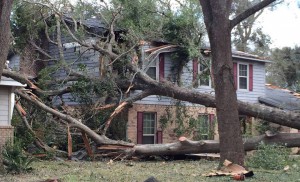
Even large, healthy oaks may fall during a tornado. Photo credit: northescambia.com
When we think of bad weather in Florida, hurricanes are typically the first thing that comes to mind. In reality, Florida is 4th in the nation in tornado frequency—and when adjusted for frequency per square mile, we are actually number 1. Residents of Escambia County are believers now, as the community reels from enduring two tornadoes in the span of a week. Both rated as EF3 storms, the winds in the twisters (136-165 mph) were nearly equivalent to a Category 4 or 5 hurricane. The western Panhandle and much of south Alabama were under tornado watches as the most recent band of thunderstorms moved through.
Based on a thorough study of surviving trees after hurricanes in Florida, there are several species of trees best suited to windstorms. For north Florida, some of the top species are: Florida scrub hickory, several native holly species, Southern magnolia, sand live oak, myrtle oak, and bald and pond cypress. Data from the full study and an in-depth overview is available from the University of Florida. To prepare for a heavy thunderstorm or a milder hurricane, it is wise to replace or plant trees with the most wind-resistant species. Because of the damage from falling trees in storms, many homeowners are nervous about planting trees. However, there are so many benefits to healthy trees in a landscape that they vastly outweigh the small risk of them falling.
Keep in mind that tornadoes are the most violent natural disasters and may cause complete devastation of homes, neighborhoods, and forests in a matter of seconds. After the Escambia County tornadoes, we witnessed large uprooted trees, downed power lines, flipped vehicles and blown-off roofs. Several homes and apartments were completely flattened or blown off their foundations. Luckily, the odds are in one’s favor of not getting hit directly by a tornado—because there’s often little anyone can do for a landscape in that situation. It’s best to hunker down in a windowless inner room or hallway, which saved the lives of hundreds during the last round of bad weather.
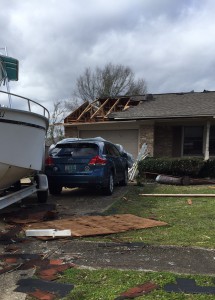
Wind entering the garage of this house may have caused the roof blowout above it. Photo credit: Carrie Stevenson
However, there’s good news that work that can be done to help protect a home during storms. Hardening homes through “windstorm mitigation” techniques can prevent updraft from strong winds. A house is only as strong as its weakest area, and those are typically the connections between the walls, roof, and foundation. A wind-rated garage door and/or brace are crucial, as strong winds can enter a garage and blow out the roof above it.
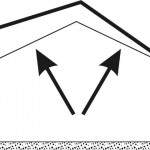
When strong winds enter a home, their force moving out can cause an updraft and lift off the roof. Graphic courtesy UF IFAS.
In Escambia and Santa Rosa County, the local nonprofit “Rebuild Northwest Florida” operates a cost-sharing program to help residents harden homes. After the tornado in Century (near the Alabama border in north Escambia County), engineers from Rebuild examined a home that suffered a direct hit from a tornado. The home had been retrofit with crucial wind mitigation techniques and sustained no structural damage. Buildings, sheds, and homes all around it were destroyed. Examples of several wind mitigation techniques, including storm shutters, wind-rated windows, garage door braces and a tornado shelter are available for public viewing at the Escambia County Extension office in our windstorm mitigation building.
As the spring storm season heats up and rolls into hurricane season, keep in mind these suggestions for both the landscape and home. As always, contact your local Extension office if you have any questions.















